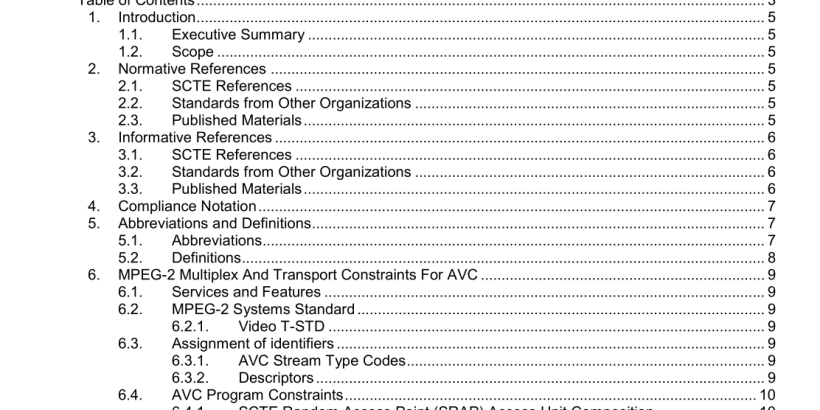ANSI SCTE 128-2-2018 pdf download.AVC Video Constraints for Cable Television
6.3.2.3. SCTE Adaptation field data descriptor
When private data bytes of the adaptation field of the TS packets are in use, with tag, length, and data structures as defined in Section 6.4.3, the SCTE_adaptation_field_data_descriptor shall be placed in the descriptor loop for the video program element of the PMT. In the absence of such adaptation field private data, the descriptor shall not be included in the corresponding ES_info_loop of the PMT. The presence of the SCTE_adaptation_field_descriptor() shall mean that private_data_byte(s) carried in adaptation field data in this stream are in tag-length-data format, where the tag values are as defined in SCTE standards. The absence of this descriptor does not preclude private data in the adaptation header that could conform to MPEG or other standards. The SCTE adaptation field data descriptor shall be formatted per Table 2.
6.4.2.2. SRAP Picture Decoding Time Stamp and SRAP Picture Presentation Time Stamp Constraints
The AVC Bitstream shall contain necessary elements such that all pictures with PTS greater than or equal to DTSSRAP + 0.5 seconds (where DTSSRAP represents the decoding time stamp of an SRAP Picture) are fully reconstructable and displayable when decoding starts at the SRAP picture. Note 1: This implies that any picture that has a PTS >= [DTSSRAP + 0.5 seconds] cannot be predicted directly or indirectly from reference pictures that were transmitted prior to the SRAP (i.e., with a lower value of DTS than DTSSRAP). This also implies that any picture that was transmitted prior to the SRAP as well as any partially reconstructed pictures in the time interval [DTSSRAP, DTSSRAP + 0.5 seconds], cannot have a PTS that is greater than or equal to [DTSSRAP + 0.5 seconds]. The time difference between the receipt of an SRAP (actual value of PCR if present in the transport packet or computed value of PCR for the transport packet containing SRAP) and the DTS/PTS of its SRAP Picture is another key component in determining channel change time. The time difference between the receipt of an SRAP and the DTS of its SRAP Picture is also known as the initial video buffering delay of the AVC Bitstream in the CPB. Like in MPEG-2 video, the maximum possible initial video buffering delay is determined by the size of the CPB divided by the AVC Bitstream’s actual bitrate. The initial video buffering delay shall be limited to 3 seconds or less. For applications requiring fast channel change or small initial delay after random access, the initial video buffering delay should be limited to one second or less.
For applications where fast channel change or random access is important, the maximum time interval between the decoding time stamp of successive SRAP Pictures shall be less than or equal to 1 second for integer frame rates, with appropriate adjustment (less than two pictures) for (1) non-integer frame rates and (2) small variabilities associated with scene change detection during encoding. Note: The frequency at which SRAP access units are inserted into an AVC Bitstream is one of the key components in determining the channel change time and may simplify splicing and trick mode operations. If the interval between the Decoding Time Stamps of two successive SRAP Pictures is too small, such as 0.2 seconds, compression efficiency might be lowered significantly. On the other hand, if the interval between the Decoding Time Stamps of two successive SRAP Pictures is too large (such as 5 seconds), the time to effect a channel change or the initial delay after random access may be longer.ANSI SCTE 128-2-2018 pdf download
